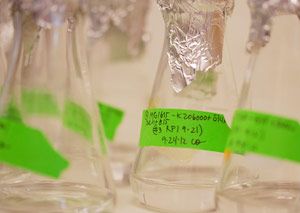Team:UC Davis/Project/Directed Evolution
From 2012.igem.org
(Difference between revisions)
| Line 1,241: | Line 1,241: | ||
<h1>History</h1> | <h1>History</h1> | ||
<article> | <article> | ||
| - | Mutants of <i>E. coli</I> able to grow on propylene glycol were selected for ethylene glycol enzymatic breakdown after ethyl methane sulfonate (EMS) mutagenesis. The culture conditions strongly selected for ethylene glycol utilizing mutants, by having ethylene glycol as the sole carbon source in liquid culture. Through directed evolution, colonies were continuously streaked on ethylene glycol plates for three more generations, in order to isolate ethylene glycol degrading mutants. Through spectrophotometric assays, increased activities of glycolaldehyde reductase and glycolaldehyde dehydrogenase were observed in the ethylene glycol isolates. | + | Mutants of <i>E. coli</I> able to grow on propylene glycol were selected for ethylene glycol enzymatic breakdown after ethyl methane sulfonate (EMS) mutagenesis by the University of Barcelona [1]. The culture conditions strongly selected for ethylene glycol utilizing mutants, by having ethylene glycol as the sole carbon source in liquid culture. Through directed evolution, colonies were continuously streaked on ethylene glycol plates for three more generations, in order to isolate ethylene glycol degrading mutants. Through spectrophotometric assays, increased activities of glycolaldehyde reductase and glycolaldehyde dehydrogenase were observed in the ethylene glycol isolates. |
</article></div> | </article></div> | ||
Revision as of 18:16, 29 September 2012

Directed Evolution
History
Genome Sequencing
Tecan Experiments


References
2. Andrianantoandro, Ernesto, Subhayu Basu, David K. Karig, and Ron Weiss. "Synthetic biology: new engineering rules for an emerging discipline." Nature - Molecular Systems Biology. (2006): n. page. Web. 29 Aug. 2012.
 "
"















